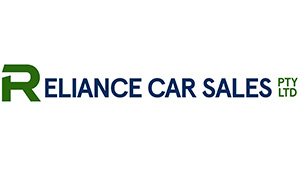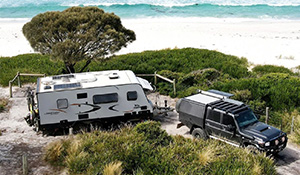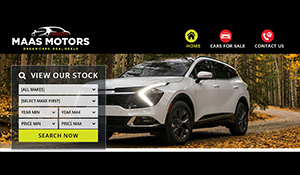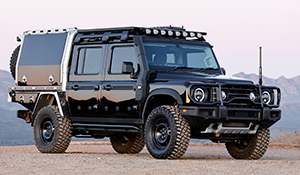1956-1957 Forward Control Jeep Review
A press release of the day explained the Forward Control Jeep trucks, "were aimed at providing maximum cargo space in relation to wheelbase."
Furthermore, "the new FC-150 has the cab situated well forward of the engine to provide more than six feet of cargo bed length despite the 81-inch wheelbase." The overall length of the FC-150 was 147.5-inches, some 38-inches shorter than a Chevrolet half-ton pickup.
Models
The Forward Control Jeep was offered in two variants. The FC-150, was the smaller of the two, and was based on the CJ-5 Jeep, 81-inch wheelbase and drivetrain mechanicals.
The FC-170 - introduced in 1957 - was a longer wheelbase, 103.5-inch model. The FC-150 came with the Hurricane four-cylinder engine. Maximum power was 75hp at 4000 rpm and 115 lb-ft. of torque at 2000 rpm. A 6.9:1 compression was standard with a 7.4:1 ratio optional.
The FC-170 was powered by the 226 cubic inch High-Torque Hurricane six-cylinder engine. It produced a maximum power of 105hp at 3000 rpm and maximum torque of 190 lb-ft. at 3600rpm.
Common to both were drum brakes, front and rear leaf springs, a two-speed transfer case and a three-speed manual with a four-speed manual option. Due to low gearing, and modest engine output the FC trucks were limited to around 50mph.
Both models were available with three power-take off points at the front, centre and rear of the chassis. The rear unit delivered up to 40hp to operate either belt or shaft-driven equipment as well as an optional draw bar. Operation of the FC in 4WD was controlled by a single transfer case lever. It could be shifted into 4WD at normal road speeds, but had to be stationary and in 4WD before Low Range could be selected.
The standard three-speed transmission was controlled by a floor-mounted shift, with a total of nine forward speeds and three reverse combinations available. If the optional 4-speed transmission was installed this increased to 12 forward power options.
Both models had full floating front and rear axles, but the FC-170 had ratings of 3700 lbs. (front) and 4500 lbs. (rear) as compared to the FC-150s respective ratings of 2300 and 300 lbs. Both trucks had identical brake systems consisting of Bendix hydraulic drums measuring 11 x 2 inches. Total area measured 178.5 sq. in.
Suspension consisted of semi-elliptical leaf springs, front and rear, with full floating front and semi-floating rear axles. The FC-170 had six springs measuring 46 x 2.5 inches at the front and 52 x 2.5 inches at the rear. The FC-150 was equipped with seven springs measuring 39.57 x 1.75 inch at the front and nine rear sprigs of 46 x 1.75 inch dimensions.
Maximum load of the FC-170 was 3700 lbs. (front) and 4500 lbs. (rear). The respective limits for the FC-150 were 2300 and 3000 lbs.
The Forward Control was only available as a 4WD.
The FC-150 required an 18 feet turning radius, while the FC-170 required 22 ft. The FC-150 utilised an 81-inch wheelbase, with an overall length of only 148 inches. The pickup box measured 74-inches in length, which provided the FC-150 with the greatest cargo area per inch of wheelbase of any truck in its class. The cargo bed was only 24 inches from the ground, which gave the FC-150 the lowest pickup box of any 4WD truck then available. The width of the cargo tray was 36 inches.
Both models were available in three body configurations: Pickup, Stake and Closed Cab and Chassis, as well as stripped chassis, flat face cowl and open cab and chassis forms for installation of special bodies. The FC-170 was also available in a dual rear wheel form.
Willys dealers also offered several special equipment items such as selective drive hubs, snow plough and dozing blades, and a tow truck setup.
Appearance
While nothing like any Jeep before them the Forward Control models were still very much recognisable as a part of the Jeep family, identified by the familiar grille design that included seven vertical cutouts, plus the head and parking lights within a perimeter shaped to suggest that of the CJ models.
The Forward Control trucks used simple and functional styling, with smooth panels, rounded corners and wrap around front windscreen. The Jeep cabin had an enormous amount of glass, with the wrap around windscreen providing excellent visibility, and combined with a large rear window and generous door and side windows, was probably a design somewhat before its time.
The FC "Safety View" cab, as it was promoted had a windscreen surface of 1200 sq. in. Jeep claimed that the forward visibility was nearly 200 percent greater than in conventional trucks.
Side doors were wide opening, and when opened revealed a safety step to assist entry.
On the tray styled models the FC came with angular rear fenders, which were very similar to those used on the conventional Jeep trucks. The front fenders were a simple raised panel of rubber construction extending along the wheel wells.
Interior
A console-type instrument panel was used, into which instruments and gauges were grouped in a cluster immediately in front of the driver. An ignition key-operated starter was used and both clutch and brake pedals were of suspended design.
A useful feature was the placement of the brake fluid access tank cover on the dash panel. Access to the engine was through an easily removed cover. The use of heavy fibreglass insulation limited the amount of engine noise and heat that entered the cab.
The standard FC cab was practical with two front seats, with adjustable driver's seat, single horn, dual windscreen wipers, key locks on both doors, ash tray, driver side visor, rear view mirror, dome light, partial roof trim, floor mats, and glovebox.
The Deluxe cab had dual sun visors, rear quarter windows, trim on the doors and headliner, foam rubber seats, cigarette lighter, front kick panels and all standard items.
Optional equipment was a new high volume heating and ventilation system, radio, two-tone exterior paint, front bumper guards, directional lights, tinted glass, windscreen washer, front air vent, electric windscreen wipers, safety belts, double passenger seat, power brakes, oil bath air cleaner, oil filter, transmission brake, Powr-Lok rear differential (vehicles with this option had a brass tag stamped with the letter "T" under one of the differential covers), heavy-duty rear axle, springs and shock absorbers, 4-speed transmission and a hot climate radiator.












